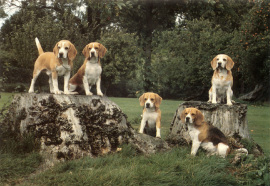History of Beagles

One of the most popular of the hounds, bred down from the larger Foxhound to hunt with men on foot, preferably after the hare. He is still used in packs, very often organised by institutions, including colleges and schools, but it is as a first-class family pet that he really makes his mark. A bustling, eager little dog, full of enthusiasm and vigor, ever ready for any activity which involves him. Sturdy, bold and active, he is the very essence of quality, and is blessed with an equable nad merry temperament. His head is powerful but his expression benign and there is usually a most definite difference between the dogs and bitches. Everything about the breed gives the impression of athleticism and there is no better sight than a Beagle pack in full pursuit, their heads down to the scent, their sterns up in rigid order as they concentrate on the chase. This instinct is mimicked in his everyday behaviour in the park; the man with the lead in his hand and no dog in sight owns a Beagle. An easy dog to keep, he can get as muddy as he likes but cleans up with a sponge and water, and dries off his short dense coat in a trice.
The Breed Standard
General Appearance:A sturdy, compactly built hound, conveying the impression of quality without coarseness. Characteristics: A merry hound whose essential function is to hunt, primarily hare, by following a scent. Bold, with great activity, stamina and determination. Alert, intelligent and of even temperament. Temperament: Amiable and alert, showing no aggression or timidity. Head and Skull: Fair length, powerful without being coarse, finer in the bitch, free from frown and wrinkle. Skull slightly domed, moderately wide, with slight peak. Stop well defined and dividing length, between occiput and tip of nose, as equally as possible. Muzzle not snipy, lips reasonably well flewed. Nose broad, preferably black, but less pigmentation permissible in lighter coloured hounds. Nostrils wide. Eyes: Dark brown or hazel, fairly large, not deep set or prominent, set well apart with mild, appealing expression. Ears: Long, with rounded tip, reaching nearly to end of nose when drawn out. Set on low, fine in texture and hanging gracefully close to cheeks. Mouth: The jaws should be strong, with a perfect, regular and complete scissor bite, i.e. upper teeth closely overlapping lower teeth and set square to the jaws. Neck: Sufficiently long to enable hound to come down easily to scent, slightly arched and showing little dewlap. Forequarters: Shoulders well laid back, not loaded. Forelegs straight and upright well under the hound, good substance, and round in bone, not tapering off to feet. Pasterns short. Elbows firm, turning neither in nor out. Height to elbow about half height at withers. Body: Topline straight and level. Chest let down to below elbow. Ribs well sprung and extending well back. Short in the couplings but well balanced. Loins powerful and supple, without excessive tuck-up. Hindquarters: Muscular thighs. Stifles well bent. Hocks firm, well let down and parallel to each other. Feet: Tight and firm. Well knuckled up and strongly padded. Not hare-footed. Nails short. Tail: Sturdy, moderately long. Set on high, carried gaily but not curled over back or inclined forward from root. Well covered with hair, especially on underside.
Gait/Movement: Back level, firm with no indication of roll. Stride free, long-reaching in front and straight without high action; hindlegs showing drive. Should not move close behind nor paddle nor plait in front. Coat:Short, dense and weatherproof. Colour: Any recognised hound colour other than liver. Tip of stern white. Size: Desirable minimum height at withers: 33 cms (13 ins). Desirable maximum height at withers: 40 cms (16 ins). Faults: Any departure from the foregoing points should be considered a fault and the seriousness with which the fault should be regarded should be in exact proportion to its degree and its effect upon the health and welfare of the dog. Note: Male animals should have two apparently normal testicles fully descended into the scrotum.
Gait/Movement: Back level, firm with no indication of roll. Stride free, long-reaching in front and straight without high action; hindlegs showing drive. Should not move close behind nor paddle nor plait in front. Coat:Short, dense and weatherproof. Colour: Any recognised hound colour other than liver. Tip of stern white. Size: Desirable minimum height at withers: 33 cms (13 ins). Desirable maximum height at withers: 40 cms (16 ins). Faults: Any departure from the foregoing points should be considered a fault and the seriousness with which the fault should be regarded should be in exact proportion to its degree and its effect upon the health and welfare of the dog. Note: Male animals should have two apparently normal testicles fully descended into the scrotum.
